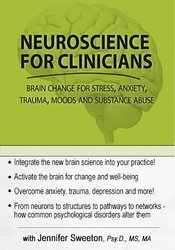Neuroscience for Clinicians: Powerful Brain-Centric Interventions to Help Your Clients Overcome Anxiety, Trauma, Substance Abuse and Depression – Jennifer Sweeton
$200.00 Original price was: $200.00.$56.00Current price is: $56.00.
Proof of item:
Neuroscience has given us incredible insights into the workings of the brain and its connection to our mental health. And recent research reveals that neuroplasticity takes place all through life, so you can offer hope for real change no matter how long your client has suffered.
This recording will connect complicated science with your clinical practice, and transform how you view and work with traumatized, stressed, addicted, anxious, and depressed clients!
Discover how and where neuroplasticity occurs, and ways to use it therapeutically. Participate in enjoyable learning experiences that provide you with the clear principles and background you need for utilizing neuroscience in your work. Draw on multiple modalities to overcome resistances, activate creative responses, and turn problems into potentials. Add new dimensions to each therapy session and initiate change using top-down, bottom-up, and horizontal methods that can be creatively individualized.
Leave this program as the most informed clinician you can be, and feel confident in bringing the latest findings from neuroscience into your treatments!
- Communicate the findings regarding neuroscientific research on the interplay of mental health and key nervous system structures, functions and pathways and recognize how understanding neurological processes can help mental health professionals improve clinical outcomes.
- Develop a case conceptualization that draws upon neuropsychological principles and can help inform therapeutic methods and goals with clients suffering from anxiety and depression.
- Analyze how CBT, meditation and other treatment approaches can strengthen or weaken neural pathways regulating stress and reward, and connect this information to your utilization of therapeutic interventions to reduce stress and manage addiction.
- Maximize capacity for change in clients with neuro-informed explanations that shift the way they feel about themselves and engage them in the therapeutic process.
- Evaluate how the science of memory malleability impacts clients working through trauma and elucidate how an understanding of implicit memory can be used clinically to identify rigid and maladaptive mental schemas, bring them into conscious awareness, and create new emotional and behavioral habits.
- Teach clients to identify the brain’s Default Mode Network and Task Mode Network and instruct them on mindfulness, meditation, and somatic techniques that can help them switch between these circuits, redirect their attention, and reduce the stress response.
Get Neuroscience for Clinicians: Powerful Brain-Centric Interventions to Help Your Clients Overcome Anxiety, Trauma, Substance Abuse and Depression of author Jennifer Sweeton
- Tour through the Brain: What clinicians need to know from neurons to structures, to pathways, to networks
- See brain structures in 3-D
- How the brain processes top-down, bottom-up, and horizontal
- The interplay of mental health and key nervous system structures, functions, and pathways
- Work with implicit and explicit memories
- How key pathways inform clinical interventions:
- Pain Pathway
- Reward Pathway
- Fear-Stress Pathway
- Nervous System Networks and the Social Brain: We are wired for attunement
- Default Mode (DMN) and Task Mode Networks (TMN)
- Healing attachment
- Activate mirror neurons bottom-up
- Neuroplasticity and Neurogenesis: How the brain can change
- Three timeframes for change
- Neuroplasticity at the synapse
- How to foster neuroplasticity in clients
- Neuroplasticity in action: Exercise your brain!
- Practice Interventions for Healing: Bottom-up, top-down, and horizontal
- Sensory Awareness
- Meditation and Mindfulness
- Body Work
- Unconscious and the DMN
- The Mind-Body Link
- Integrate the Brain into Treatments
- Stress
- How stress alters the nervous system
- Calm the stress/fear pathway
- Develop alert/relaxed attention for better coping
- Trauma
- Foster confidence with yoga
- Malleability of memories and clinical implications for treating trauma
- Reconsolidate implicit memories
- Anxiety
- The anxious brain reaction
- Work top down/ bottom up/ horizontally
- Calm the limbic system bottom up with movement
- Soothe the insula through meditative sensory awareness
- Deconstruct sensations mindfully
- Substance Abuse
- Brain areas involved in addictions
- Rewire the reward pathway
- Detach from pleasure and pain
- Prefrontal connections and judgment
- Depression
- The depressed brain pattern
- Effects of yoga and meditation on the nervous system
- Regulate the limbic system: the prefrontal cortex, cingulate gyrus and mindfulness
- Unify real and ideal
- Foster joyful relationship through mirror neurons
- Develop compassion and gratitude
- Stress
- 6 Principles for Incorporating the Brain into your Therapy
Get Neuroscience for Clinicians: Powerful Brain-Centric Interventions to Help Your Clients Overcome Anxiety, Trauma, Substance Abuse and Depression of author Jennifer Sweeton
1 review for Neuroscience for Clinicians: Powerful Brain-Centric Interventions to Help Your Clients Overcome Anxiety, Trauma, Substance Abuse and Depression – Jennifer Sweeton
| 5 star | 100 | 100% |
| 4 star | 0% | |
| 3 star | 0% | |
| 2 star | 0% | |
| 1 star | 0% |
Sorry, no reviews match your current selections
Q & A
Related products
Personal Development
Personal Development
Personal Development
Personal Development
Personal Development
Personal Development
Reuben Brooks – The Ultimate Transformation – Meal Plan & Training Program
Personal Development
Personal Development














Fast shipping thank you! | Neuroscience for Clinicians: Powerful Brain-Centric Interventions to Help Your Clients Overcome Anxiety, Trauma, Substance Abuse and Depression – Jennifer Sweeton